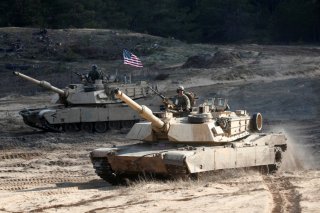AbramsX: America’s Next Tank Could Revolutionize Ground War
In some scenarios, the hybrid AbramsX would lower the tanks’ increasingly problematic weight, extending range and allowing the tank to drive nearly entirely silently.
General Dynamics, the American defense firm behind the highly successful Abrams main battle tank, just revealed its concept for the future of the Abrams.
In a press release, General Dynamics explained that the AbramsX concept is “a main battle tank for the next generation, the AbramsX technology demonstrator features reduced weight for improved mobility and transportability, delivering the same tactical range as the M1A2 Abrams with 50% less fuel consumption.”
The new tank’s reduced fuel consumption is thanks to the “AbramsX’s hybrid power pack,” which “supports the U.S. Army’s climate and electrification strategies, enhances silent watch capability, and even allows for some silent mobility.
The General Dynamics statement also explained that “with a reduced crew size and AI-enabled lethality, survivability, mobility, manned/unmanned teaming (MUM-T) and autonomous capabilities, AbramsX can be a key node in lethal battlefield networks and serve as a bridge from Abrams SEPv3 and SEPv4 to a future tank.”
Compared to the latest generation Abrams tank, the new AbramsX appears to have a very different hull and turret design, which supports General Dynamics’s intent to lower the Abrams’ curb weight. Though a highly capable design, the Abrams, in its current iteration, is one of the heaviest main battle tanks in existence, a factor that adversely affects transportation and logistics—and also lowers the tank’s combat radius.
M1A2 System Enhanced Package Version 3 (SEPv3) tank is the most modernized version of the Abrams tank—and tips the scales at over 70 tons. But, combined with its physical dimensions, the Abrams is a logistical nightmare, particularly for navigating Europe’s road and bridge infrastructure.
Though the new hybrid feature would help the Abrams’ fuel efficiency, it has the added benefit of allowing silent drive at low speeds, masking the tank’s sound in certain low-speed scenarios.
One of the big question marks surrounding the design is General Dynamic’s apparent intent to move from a four-man crew—commander, driver, gunner, loader, and driver, to a three-man crew, with the loader likely replaced by an automatic loading system.
A three-man crew would be a radical departure from previous U.S. tank designs and more in line with Soviet-style three-man tank crews, which incorporate an automatic loader. Though Soviet and now Russian tanks are smaller and lower to the ground than their western counterparts, thanks in part to a reduced, 3-man crew, the ongoing war in Ukraine has shown a significant weakness in the design, which does not incorporate blow-out compartments for ammunition, but rather places ammunition inside the belly of the tank and can more easily cook-off and kill tank crews.
Caleb Larson is a multimedia journalist and defense writer with the National Interest. A graduate of UCLA, he also holds a Master of Public Policy and lives in Berlin. He covers the intersection of conflict, security, and technology, focusing on American foreign policy, European security, and German society for both print and radio. Follow him on Twitter @calebmlarson
Image: Reuters.

